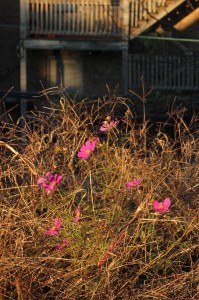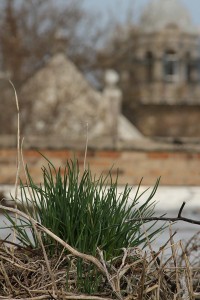 Chives start out strong in a debris clump. Raspberries are sprouting in front parkway. Started to dismantle alley planters today. Dumped almost 8 cu. ft. in front parkway. I decided not to build anything raised in that area — only by the stop sign. More on that later ….
Chives start out strong in a debris clump. Raspberries are sprouting in front parkway. Started to dismantle alley planters today. Dumped almost 8 cu. ft. in front parkway. I decided not to build anything raised in that area — only by the stop sign. More on that later ….
Tag Archives: debris clump
Debris Clumps
 Here are a couple debris clumps taken in early morning light. To the right in heavy shade are the 14 caged positions as they were last year, albeit with somewhat different buffer and companion plants. We’ll get more into that later. Due to the rain the debris clumps, clumps of old planter matter and mix have maintained their green. Some have mint and chives growing. If I see a tree I’ll pull it before the roots try and penetrate the rubber roofing. For the most part the rest of the plants that grow in these are harmless. I typically don’t water them nor do I seed them. When dry they can be kicked around the roof like a hockey puck.
Here are a couple debris clumps taken in early morning light. To the right in heavy shade are the 14 caged positions as they were last year, albeit with somewhat different buffer and companion plants. We’ll get more into that later. Due to the rain the debris clumps, clumps of old planter matter and mix have maintained their green. Some have mint and chives growing. If I see a tree I’ll pull it before the roots try and penetrate the rubber roofing. For the most part the rest of the plants that grow in these are harmless. I typically don’t water them nor do I seed them. When dry they can be kicked around the roof like a hockey puck.
Debris clumps
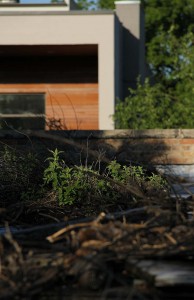 Pineapple mint has taken over and has set up beach heads in several debris clumps. Debris clumps are gatherings of old discarded potting mix and plant carcasses left on the roof surface to support whatever it is that can grow in that environment. These have been discussed here in previous years. Last year these clumps didn’t fare too well due to drought conditions. I typically do not water them nor do I seed them. Whatever grows in them happens by sheer accident. More of these will be shown as the season progresses. The building in the background is a new feature this year.
Pineapple mint has taken over and has set up beach heads in several debris clumps. Debris clumps are gatherings of old discarded potting mix and plant carcasses left on the roof surface to support whatever it is that can grow in that environment. These have been discussed here in previous years. Last year these clumps didn’t fare too well due to drought conditions. I typically do not water them nor do I seed them. Whatever grows in them happens by sheer accident. More of these will be shown as the season progresses. The building in the background is a new feature this year.
Tomato Patch Status
 Here’s a pic of all 14 caged positions taken at an angle. The big pink flowers are Cleome which draw the bees which theoretically should help the tomato plants. In the foreground to the left is the debris clump Lost Island from last season. Debris clumps are piles of old plant carcasses and roots that have been tossed onto the roof and left to support anything that can grow in that environment. The debris clumps have sufferred this year from drought conditions but plant life still recovers in them. More on them later.
Here’s a pic of all 14 caged positions taken at an angle. The big pink flowers are Cleome which draw the bees which theoretically should help the tomato plants. In the foreground to the left is the debris clump Lost Island from last season. Debris clumps are piles of old plant carcasses and roots that have been tossed onto the roof and left to support anything that can grow in that environment. The debris clumps have sufferred this year from drought conditions but plant life still recovers in them. More on them later.
Update on tomatoes: Lots of strong second growth but mites are getting higher and higher. May need to do another hard prune in a few days. Giving them two hard showers tonight. Heading to Home Depot for that Neem organic stuff tomorrow. Although this is frustrating, I think my actions might have some effect. Compared to last year’s photos, the tomatoes look much better this year at this date.
Update 8/1: Didn’t get Neem but got some bottle containing a bunch of oils claiming to be organic. Gave tomatoes another hard shower and applied about 1/2 a bottle of that spray on all 8. Pulled a few samples and saw some mites but not many. Still lots of curled leaves and it seems relentless. Even though the plants are growing well it seems as if the mites might eventually win. Hopefully this spray has some effect. Will water everything later tonight. In a few days we’ll hit the date when everything really went south last year. The green tomatoes look good however. Nice and round and no BER (knock on wood). May have to do another hard prune soon. Probably should fertilize too. Will fertilize tonight.
Tomatoes in morning light
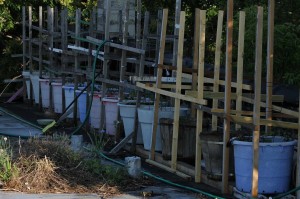 This photo shows the tomatoes at around 7:30 am on 6/3. They’re still shaded nicely. Sunrise is around 5:16am so they get over 2 1/2 hours of morning shade. The south side of the roof gets no shade. The debris clump in the sunlight is suffering from drought. We’ll see how these fare this year under drought conditions. I have identified two leaks in the roof that need repair — exact location not completely known. I do not suspect the debris clumps however. The tomato patch and two corners are the only things growing up there this year giving me room to do some roof repairs. Much of the roof needs that silver paint. I might look into white instead.
This photo shows the tomatoes at around 7:30 am on 6/3. They’re still shaded nicely. Sunrise is around 5:16am so they get over 2 1/2 hours of morning shade. The south side of the roof gets no shade. The debris clump in the sunlight is suffering from drought. We’ll see how these fare this year under drought conditions. I have identified two leaks in the roof that need repair — exact location not completely known. I do not suspect the debris clumps however. The tomato patch and two corners are the only things growing up there this year giving me room to do some roof repairs. Much of the roof needs that silver paint. I might look into white instead.
The following is for log book purposes. The 14 caged positions have been planted with the following:
1 – two Cleome 2 – Celebrity 3 – two eggplants 4 – Big Boy 5 – I’ll fill this in later.
NE corner main roof status
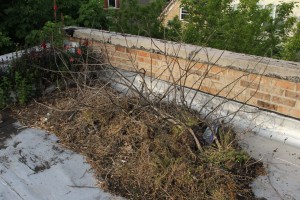 The white box in the corner is badly collapsed and needs replacing. Huge snapdragons are growing out of the sides however and I don’t want to disturb them this year. I don’t know how snapdragons can get so large since I thought they grew from seed every year.
The white box in the corner is badly collapsed and needs replacing. Huge snapdragons are growing out of the sides however and I don’t want to disturb them this year. I don’t know how snapdragons can get so large since I thought they grew from seed every year.
The debris clump in the forefront is in its second year and starting to get green growth. The plant skeletons were put in this year. This debris clump sits at the top of the roof so it gets the least amount of water of all clumps during rains. I suspect that won’t matter since any rain will completely saturate it anyway. In other words, the water going under a debris clump will only matter if that’s part of the irrigation system.
Debris Clump
Cosmos in debris clump
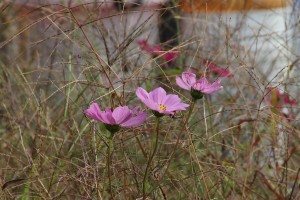 Cosmos grow amongst two year old debris clump occupying the western edge of main roof. These clumps are going through drought periods. I haven’t been diligent watering since the tomatoes died. The wildflowers are still popping up however and blooming. I cheated and seeded these. The grass and most all other plants in these clumps comes from whatever seeds make it and survive.
Cosmos grow amongst two year old debris clump occupying the western edge of main roof. These clumps are going through drought periods. I haven’t been diligent watering since the tomatoes died. The wildflowers are still popping up however and blooming. I cheated and seeded these. The grass and most all other plants in these clumps comes from whatever seeds make it and survive.
Lost Island
More Debris Clumps
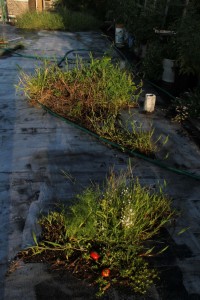 Here’s a nice shot of three debris clumps in morning light. The far clump is in its second year. Lost island is in the middle and the greenery is starting to take hold. Debris clumps are light, portable groups of plants that can go into dormancy. They are light enough where they can occupy middle areas of the roof. The roots don’t bond to anything so they can be easily moved. Theoretically an entire roof could consist of these. They would need some watering regime. I’ll find out this summer if one of them puts a hole in my rubber roof. A problem I see is that an elm seed starts to grow and that would mean tree roots. Tree roots can go through concrete. IMHO, green roofs should be inspected frequently.
Here’s a nice shot of three debris clumps in morning light. The far clump is in its second year. Lost island is in the middle and the greenery is starting to take hold. Debris clumps are light, portable groups of plants that can go into dormancy. They are light enough where they can occupy middle areas of the roof. The roots don’t bond to anything so they can be easily moved. Theoretically an entire roof could consist of these. They would need some watering regime. I’ll find out this summer if one of them puts a hole in my rubber roof. A problem I see is that an elm seed starts to grow and that would mean tree roots. Tree roots can go through concrete. IMHO, green roofs should be inspected frequently.

